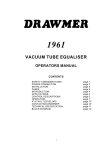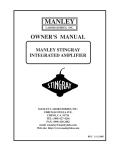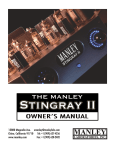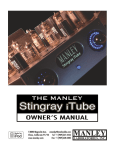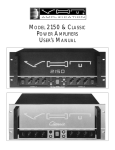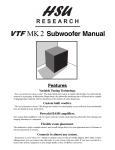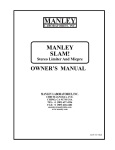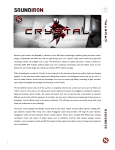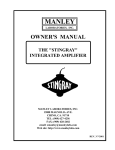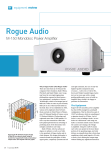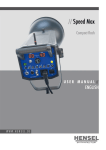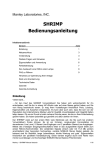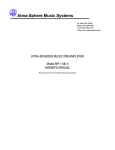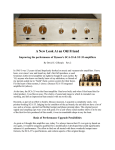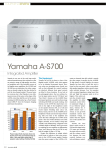Download Manley STINGRAY INTEGRATED AMPLIFIER Specifications
Transcript
er equipment review Manley Laboratories Stingray Valve Integrated Amplifier Legend has it that EveAnna Manley named the Stingray following a chance remark by the legendary J. Gordon Holt*, founder of Stereophile magazine, who after looking at a bar-napkin sketch Ms Manley had propped up next to his martini during a high-end show, remarked that she’d drawn a picture of a stingray. I have no idea of whether this story is true or not, but the amplifier is certainly called a ‘Stingray’ and it does have a stylised illustration of a Stingray on the front panel that looks as if it could have been drawn on a bar napkin—and, if you get the angle exactly right when looking at the amplifier from above, it does indeed look a little like a Stingray. However, even if you don’t agree that the amplifier looks like a Stingray, you’d have to admit that it’s certainly a very unusual-looking amplifier: there aren’t too many amplifiers with six sides—nor have there ever been. (And contrary to some reports, it’s not a hexagon!) The Equipment You don’t need me to tell you it’s a valve amplifier. For those ‘in the know’, the fact that it’s made by Manley Laboratories would be sufficient, while for those not in the know, the photograph above speaks for itself. What you do need me to tell you is that it’s a push-pull integrated amplifier that’s rated at 40-watts per channel *Since Australians are renowned for claiming anyone famous as being ‘one of our own’ if there’s even the most tenuous link to Australia (such as being born and raised in New Zealand!), there’s a good case for us claiming Holt as an Aussie. Although he was born in the US, Gordon J. Holt arrived in Australia in 1935 and lived in Melbourne until 1952, during which time he became a published writer, selling 20 | into 5Ω. The Stingray used to be rated at 50-watts per channel, but that was before Manley Labs decided to make the output stage switchable between ultralinear and triode operation. The dual-mode amplifier is now rated at 40-watts (ultralinear) or 20-watts (triode). Owners of single-mode (ultralinear) Stingrays can have their old models upgraded if they want. The model I received, hence the one reviewed here, was a single-mode Stingray. Why 5Ω when most speakers are 4Ω, 6Ω, or 8Ω? It’s not as strange as you’d think, because the varying impedance of all moving coil loudspeakers means that any output transformer secondary will be incorrectly matched a lot of the time, so picking a ‘midway’ point his first story on the design and construction of a batteryoperated portable radio to the magazine Radio and Hobbies, which later became Electronics Australia. He has stated for the record that the descriptive language he used in the first issue of Stereophile was ‘borrowed’ from the Radiotron Designer’s Handbook published by the Amalgamated Wireless Valve Company of Australia, later to become AWA. Australian Hi-Fi ManleylabHFSep06.indd 20 22/01/2009 1:55:37 PM Manley Laboratories between two common impedances makes a lot more sense than picking a ‘standard’ impedance. In fact, the Stingray will drive impedances of between 3 and 10Ω. It’s not at all happy with an open circuit, so you should never operate it without any speakers connected. (This would not be sensible with any valve amplifier, but in this case the Owners’ Manual specifically warns against it.) The two controls on the front panel are for channel balance (left) and volume (right). In between is the backlit ‘Stingray’ panel that somewhat superfluously indicates the amplifier power is ‘On.’ I say superfluously because if the valves are glowing red, then the amplifier is very obviously on, irrespective of whether the panel is illuminated or not! (Manley makes exactly this point in its Owners’ Manual, pointing out that if the panel isn’t glowing, it probably means the lamp needs replacing, pointing out in passing that although the lamp looks like a fuse, it isn’t. I can’t remember ever seeing a lamp like this before, so if yours dies, I wouldn’t bother going down to your local shop to try to locate one, but would instead recommend going direct to Manley’s Australian distributor, Syntec, for a replacement. That said, I wasn’t that keen on the look of the illuminated logo anyway, so if the lamp on mine died, I’d leave well enough alone. It’s when you come to the input source switching process that things start to become very interesting. There are TWO source switches: one for the right channel and the other for the left channel. These are located on opposite sides of the amplifier, right around the ‘back’, on the two hindmost ‘wings’ of the Stingray. Alongside each are four RCA input terminals, so four source components can be accommodated. This is quite a problematical arrangement. Firstly because it means that if you want to switch sources, you not only have to reach around the back of the amplifier (making sure to keep your hand and arm clear of hot valves), but you also have to switch TWO source switches, rather than just the one. Of this EveAnna says ‘We realise splitting left and right this way with individual input select switches may be a problem for some—sorry. We did it this way because a good percentage of people rely on only one source 95 per cent of the time and because it provides you with the maximum stereo separation at the lowest cost. Yes it could have been more convenient but it would have cost more [if] we had to use 10 ‘runs’ of good shielded wire and it wouldn’t have sounded quite as good.’ Secondly, it means you’ll need to use custom individual interconnect cables, because the standard ‘paired’ types won’t fit. Thirdly, it also means that one of each pair of RCA interconnects will have to run either over or under the power cord unless you’re very inventive when it comes to positioning the amplifier and your source components. Needless to say, the mains power switch is also located behind the amplifier, on the small ‘flat’ at the very rear. Manley’s manual helpfully notes: ‘You should be able to ‘feel’ the rocker switch located next to the AC power cord. Flip the switch away from the power cord to turn on the Stingray, or towards the power cord to turn off the unit.’ Again, if you’re turning the unit off, watch out for hot valves! (I suspect most users may find it easier to run the Stingray’s power cord down to a switched power block or mains power conditioner and turn the amplifier on and off there instead.) As for leaving the unit on, neither Manley nor I advise it (at least not if you want your valves to have a halfway respectable life). Again in the words of the manual: ‘It is not recommended that you leave your Stingray stay permanently switched on (sic). This only wastes electricity and tube life. The Stingray reaches peak operating condition in approximately 30 minutes.’ Connecting the speaker wires also entails negotiating a hazard. The speaker binding posts, although properly insulated themselves, are fixed to the stainless steel top plate immediately in front of—and exceedingly close to—the output transformers. If you use a long banana plug, or don’t trim the ends of your speaker cable, it’s possible that the wires could touch the transformer case and short out, with the potential of damaging the amplifier. Indeed the plugs I use on my cable did exactly this when I connected up the amplifier, though I realised the danger immediately, and had not at that stage even connected the mains power cable. To its credit, the Owners’ Manual has a very large and prominent warning to this effect, complete with an illustration showing Brand: Manley Laboratories Model: Stingray Category: Valve Integrated Amplifier RRP: $2,799.00 Warranty: Five Years (Valves: 6 months) Distributor: Syntec International Pty Ltd Address: 60 Gibbes Street Chatswood NSW 2067 T: 1800 648 628 T: (02) 9417 4700 F: (02) 9417 6136 E: [email protected] W: www.syntec.com.au the potential problem, with a large ‘NO!’ overprinted over the diagram. As you can see, there are lots—and lots!—of valves on the Stingray: eight EL84s, two 12AT7s and two 6414s. There doesn’t seem to be a lot of consistency with the valves that ship as ‘standard’, with Manley Laboratories saying it will provide either EI6BQ5 or EL84M output valves, GE or Raytheon JAN NOS USA or 6414W drivers, and 12ATWA or 12AT7 Large Plate Input valves. All the valves on the amplifier provided for review were unmarked except for the valve identifiers and a label proclaiming they were ‘Made in Yugoslavia.’ (Which, since Yugoslavia hasn’t been a country for some time, means the valves were very definitely ‘New Old Stock’ [NOS]!) It’s important that the eight output valves are correctly biased, which Manley does at the factory, and for which appropriate test points are provided on the amplifier. However, a little to my surprise, Manley doesn’t seem too fussed about the need to bias the valves regularly, saying that: ‘Some people never do’—which seemed a little cavalier to me. Further on in the manual I was relieved to find the advice: ‘We suggest you check every three months—that way you are assured that the amp is running optimally and will spot a tube on its way out. Some check every month, once a week is getting a little obsessive.’ The instructions for biasing are excellent. They’re clear, lucid, to the point and leave no room for misinterpretation. They also say that before you start, you’ll need to go out and buy yourself a properly insulated flat-bladed screwdriver and a multimeter Australian Hi-Fi ManleylabHFSep06.indd 21 | 21 22/01/2009 1:55:46 PM er Manley Laboratories Stingray Valve Integrated Amplifier and interesting article on ‘Optimising Your Sound System’ along with the expected explanations of ‘Replacing the Tubes’ and ‘Setting the Bias.’ Listening Sessions (voltmeter). Now I can understand why Manley wouldn’t supply a multimeter, even though you’ll be able to pick a suitable one up at a Dick Smith or Jaycar store for less than $10, but why it couldn’t supply the screwdriver is completely beyond me. Buy a screwdriver from Dick Smith or Jaycar while you’re there buying your multimeter, and make sure you get a screwdriver that’s insulated right the way down the shaft to the tip, and has at least a 1000-volt insulation rating. Buy just the one screwdriver and you’ll be up for the princely sum of $3.95 according to the 2006 Jaycar catalogue. I’d recommend you instead lash out, hock the farm and buy a nice 7-piece insulated screwdriver set in a plastic hard case. RRP? $19.95! Not surprisingly there is no remote control, but I was a little surprised to find there isn’t a headphone output either. There wasn’t a record loop on my Stingray, but Manley has recently addressed this oversight. In fact the models now available not only have record loops, but also subwoofer outputs! The subwoofer outputs come after the volume control so that the subwoofer volume tracks the volume of your main speakers. The record loop can be made active or bypassed by means of a toggle switch. Manley has also introduced an optional ‘Skipjack’ input extender which, if inserted in the record loop, effectively adds a further four inputs to the Stingray, for a total of eight inputs. As with the triode upgrade, older Stingrays can be retrofitted with record loops and subwoofer outputs. It’s a fairly simple upgrade, because the additions are entirely passive, involving no 22 | active electronics: not even buffers. This means, for example, that the ‘Record Out’ is simply paralleled off the input selector switch, so whatever source is selected is passed through to the ‘Record Out.’ The most important point to note about this method of providing the feature is that unlike most ‘Record Out’ selectors, the one on the Manley does not allow you to listen to one source at the same time you’re recording another. The other point to note is that due to this method of connection, the input impedance of your recorder will load down the input source you’ve selected. This is unlikely to be a problem, but you should bear it in mind. Manley recommends you connect a recorder only when you are actually recording. Circuit Highlights You don’t get a schematic with the Stingray, but one is available once you have registered your purchase on Manley’s website, which is a good reason for so registering. I’d recommend you obtain one and save it as a hardcopy along with your Owners’ Manual (one of these is supplied with every amp, but it’s also available on-line as a ‘freebie’). Examine the schematic and you’ll find the input goes from the dual-triode 12AT7 on to the 6414 dual-triode phase splitter. The plates of these then drive EL84 pairs in ultralinear push-pull mode. Examine the circuit itself and you’ll find the workmanship is exemplary—particularly the point-to-point wiring—and you will also find that Manley hasn’t spared any expense on the internal components. Those who take the time to read the Owners’ Manual will find a long Unlike its namesake, Manley’s Stingray is a little slow off the mark. Switch it on from cold and you can begin playback almost instantly, but you’ll find the highs a little strident and the bass a tad soggy for the first five minutes or so, after which they’ll start to improve quite noticeably for 25 to 30 minutes after which the Stingray will start delivering its peak performance. This, of course, assumes that you—or your dealer—has already burnt-in the amplifier. You’ll be able to smell if your amplifier hasn’t been burnt-in: if it doesn’t smell when you first switch it on it has been burnt-in, and if it does smell, it hasn’t. In the event your Stingray needs burningin, do so by leaving the amplifier on for a complete weekend, preferably playing music all the time (just put a CD on repeat to take the amplifier through the nights, leaving the volume control so your speakers are only whispering away quietly). This burning-in procedure only needs to be done the once. I noted that the heaters on my two 12AT7s ‘flared’ on turn-on (from cold). This didn’t happen when the valves were warm, so I assume is characteristic of the design—or perhaps unique to my sample. I would have preferred that they didn’t. Peak performance is very good indeed. The Stingray is able to deliver the typically warm and generous performance of a valve amplifier whilst maintaining a quite accurate bottom end to deliver bass with excellent initial impact and only the faintest overhang. It’s also able to deliver ‘sizzle’ in the top-end. Indeed with the first pair of speakers I tried the sound seemed to me to be rather too bright, so I swapped for another pair to find the brightness disappeared entirely, but the quality of the bass was almost identical—along with the overall ‘loudness’ of the system. From this I surmised that the output impedance of the amplifier was likely quite high, which means that its performance will vary quite considerably depending on the electrical impedance of the speakers you connect to it. A later discussion with editor Greg Borrowman Australian Hi-Fi ManleylabHFSep06.indd 22 22/01/2009 1:55:55 PM Manley Laboratories Stingray Valve Integrated Amplifier not only proved the truth of my surmise, but that I had completely overlooked a note on the ‘Specifications’ page supplied by Manley that advised the amplifier’s ‘actual’ output impedance was 2.8Ω at 20Hz, 2.6Ω at 100Hz and 2Ω at 1kHz. OK, OK, so I never was one for reading the specifications… Mea culpa. What this means is that you should either choose your speakers to match the Stingray, or make sure you audition the Stingray with the same speakers you will be using with them. I’d also advise this ‘use the same speakers’ approach because I didn’t find the Stingray an overly powerful amplifier. My usual amplifier delivers just over 112 measured watts into my loudspeakers and, although this is more than enough almost all of the time, I find myself from time to time wishing for a little more power. So with this history it wasn’t at all surprising that I found myself wishing for a little more power than the Stingray’s 50-watts per channel. That said, you have to bear in mind that I’m a real ‘Yes’ man in that: ‘Yes I have a large room’; ‘Yes I have very inefficient loudspeakers’; and ‘Yes I like to listen at very high volume levels.’ For the most part, when I was listening at what would be considered ‘normal’ listening levels, (which, truth be told, was almost all the time!) the Stingray was cruising along, with plenty of power in reserve, even with my inefficient speakers. Connected to speakers rated at close to 90dBSPL or higher, in a typically-sized lounge room, I don’t think the Stingray’s power output will be an issue even if you listen at earth-shatteringly loud levels. And when I say ‘cruising’, you can 24 | hear this is the case just by listening to the quality of the midrange, which is absolutely gorgeous. The detailing of the sound is almost surreal in its accuracy, yet unlike solid-state ‘accuracy’ is delivered with a transparent musicality that seems to connect directly with the instruments creating the sound, rather than to them via an electronic intermediary. This is immediately noticeable with any musical instrument—though for best effect you should listen to a properly miked acoustic instrument, be it guitar, violin, cello, flute, whatever…—but most breathtaking with human voices. Note here that I have used the plural. Sure the Stingray sounds great with one voice, but when you listen to ‘voices’ as in vocal duos right up to large choirs, the sound becomes nothing short of ethereal—real ‘to die for’ tonality that cuts to the underlying emotion of the work, rather than simply highlighting the raw notes. This same ability to connect directly with instruments is a characteristic of the bass as well, though the Stingray’s ability to ‘control’ very large bass drivers means the bass will lose a little focus when driving loudspeakers with 381mm (15 inch) bass drivers, even if these drivers are very efficient. Driving designs that have 300mm (12 inch) diameter (or smaller) drivers is no problem, even if the design uses multiple bass drivers—as in most floor-standers. When used with bookshelf speakers, the Stingray has the entirely admirable quality of making them seem to have rather more bass than usual, without that additional level appearing ‘synthetic’. The best, however, has yet to come. So far, I’d been using the valves supplied with the Stingray, on the basis that this is the way ordinary consumers are going to experience the amplifier. I then replaced the output and input valves from my own valve stash, using my precious Mullards and Siemens, and re-biased. The sound opened up, improving significantly on all counts, but most dramatic of all was the expansion in the stereo soundstage. Previously, the width of the image was more than acceptable, but the depth a little shallow, as if the musicians were clustered towards the front of the performance space, rather than being arrayed behind each other. Following my valve substitution, the depth of the image improved magnificently. To all intents and purposes, it was as if I were listening to a completely different—and clearly superior—amplifier. Conclusion Manley’s Stingray is an object lesson for all audiophiles intrigued by the many subtleties inherent in the pursuit of the Holy Grail of superior audio performance. In the wrong hands, Manley’s Stingray could easily be overlooked as ‘just another fish’—notwithstanding its unusual appearance! But for an audiophile ‘skilled in the art’ who is prepared to choose speakers sensitively—and I mean this in all senses of the word—and invest energy in both carefully selecting input and output valves and in biasing them correctly, Manley’s Stingray will be a rare delicacy that can be enjoyed time and time again. Chris Croft LAB REPORT er Readers interested in a full technical appraisal of the performance of the Manley Laboratories Stingray Integrated Amplifier should continue on and read the LABORATORY REPORT published on the following pages. All readers should note that the results mentioned in the report, tabulated in performance charts and/or displayed using graphs and/or photographs should be construed as applying only to the specific sample tested. Australian Hi-Fi ManleylabHFSep06.indd 24 22/01/2009 1:56:08 PM er Manley Laboratories Stingray Valve Integrated Amplifier Test Results Newport Test Laboratories usually measures the power output of an amplifier at either clipping, if no other waveform distortion is visible, or at 1.0% THD+N if waveform distortion occurs prior to clipping. This works well for solid-state amplifiers which have very little distortion, but not with valve amplifiers, which usually have fairly high average distortion levels and a variety of different waveform nonlinearities as they near their maximum power output. Reconciling measured output with claimed output is further complicated by the fact that most valve amplifier manufacturers state their maximum power output when THD+N is equal to 3.0% or even more. In the case of the Stingray, the reporting of power output is further complicated by Manley Laboratory’s decision to optimise the output into a ‘non-standard’ 5Ω load. After some discussion about whether to measure the Stingray’s power output into a 5Ω load, it was decided that in the interests of uniformity, in being able to compare with other amplifiers, the output would be measured into the standard load resistances of 8Ω, 4Ω and 2Ω. As you can see from the tabulated results, power output was remarkably uniform across the different loads. If Manley had instead opted for a standard load, one might have expected maximum output into that load, and much less into the other two. Generally, the Stingray delivered 30-watts of power into all load impedances at 1kHz, reducing to 20watts at 20kHz, when using 1.0% THD as the ‘bar’. This 30-watt figure is 1.2dB lower than specification, though Manley uses a higher THD figure (1.5%) which effectively ‘lowers’ the bar. Indeed the Stingray can deliver 50-watts of power into 8Ω, but only at a frequency of 1kHz, and only with a significantly distorted waveform (around 10% THD). The amplifier could not sustain this power output at either 20Hz or 20kHz into 8Ω, where output fell to just 20-watts. The Stingray’s frequency response into 8Ω and 4Ω non-inductive loads was moderately extended, stretching from 10Hz to 53kHz –1dB (normalised, this would be 10Hz to 53kHz ±0.5dB) and from 4.7Hz to 72kHz –3dB. The accompanying graph shows the frequency response between 5Hz and 30kHz into an 8Ω resistive load (black trace), a 4Ω 26 | resistive load (blue trace) and into a load similar to that of a two-way bass reflex loudspeaker (red trace). The shift in level between the 8Ω and 4Ω traces is the direct result of the Stingray’s low output impedance, measured as 3.8Ω at 20Hz, 3.6Ω at 1kHz and 3.8Ω at 20kHz. The effect of this varying impedance on the response into a simulated speaker is evident on the graph, with the response swinging almost 2dB, from a –1.5dB low at 4.5kHz to a +0.5dB peak at 20kHz. Channel separation measured 68dB at 20Hz and 69dB at 1kHz, both of which are excellent results, reducing to 52dB at 20kHz (and 49dB at 30kHz). The Stingray does not invert polarity and input impedance was high, averaging TEST RESULTS around 47kΩ for midpoint settings of the volume control and dropping slightly at extreme settings. Channel balance was 0.4029dB, which is pretty good for what is essentially a dual mono design approach. Channel phase was very good at 1kHz, but more than 8 degrees in error at 20Hz and nearly 5 degrees at 20kHz. To put this into perspective, the error at 20kHz is on a par with the phase error in most bit-stream CD players. Signal-to-noise ratios were adequate, with the weighted noise below 1-watt coming in at 79dB. There wasn’t the expected improvement when using rated output as reference, with the A-weighted signal-to-noise ratio increasing by just 1dB, to 80dB. THD+N at one watt was Australian Hi-Fi ManleylabHFSep06.indd 26 22/01/2009 1:56:11 PM er 0.08%, increasing to 10.29% at 50-watts, under the test conditions noted earlier. The spectrograms show the output spectrum of the Stingray with a 1kHz test signal at 1-watt and 25-watts into 4Ω and 8Ω loads. At one watt, the secondharmonic distortion component rises from –60dB (0.1%) when driving 8Ω loads to –50dB (0.3%) when driving 4Ω loads. The third harmonic increases only slightly, from around –78dB (0.01%) to –70dB (0.03%). The sidebands visible around the fundamental and harmonics are caused by the Stingray’s power supply. They’re even more obvious on the spectrograms showing distortion at 25-watts. Look at the 4Ω graph and you can see the second, third and fourth harmonic distortion components are all very high at around –43dB, –45dB and –50dB respectively. At –43dB, the second harmonic is 0.7% distortion. The levels of the first three harmonic distortion components are slightly lower when the amplifier is driving an 8Ω load, but not by much. Perhaps more importantly, two of the higher-order distortion components, the 5th and 6th, are also prominent at around –70dB and –80dB, with their relative level switching with the load. Square wave testing revealed a peak in the amplifier’s frequency response at around 95kHz that was responsible for the considerable ripple across the 10kHz waveform and is also visible on the 1kHz square wave. The considerable tilt on the 100Hz square wave is indicative of the limitations of the amplifier’s lowfrequency performance, as noted in the frequency response tests. The ‘bending’ of the flat tops and bottoms of this square wave is caused by the low-frequency phase shift also mentioned previously. Although it, too, shows the effect of the peak in the high-frequency response, the square wave showing the Stingray’s performance into a highly capacitative load (2µF across 8Ω) is otherwise excellent, showing good stability. Steve Holding 28 | TEST RESULTS Manley Laboratories Stingray Valve Integrated Amplifier Manley Laboratories Stingray Integrated Valve Power Amplifier Power Output using 5 ohm tap (Ultra Linear Outputs Mode) No of Load (Ω) Channels 20Hz 20Hz 1kHz 1kHz 20kHz 20kHz (watts) (dBW) (watts) (dBW) (watts) (dBW) 1 8Ω 24 13.8 31 14.9 24 13.8 2 8Ω 24 13.8 31 14.9 24 13.8 1 4Ω 28 14.5 30 14.9 20 13.0 2 4Ω 28 14.5 30 14.9 20 13.0 1 2Ω 28 14.5 30 14.9 20 13.0 2 2Ω 28 14.5 30 14.9 20 13.0 Manley Laboratories Stingray Integrated Valve Power Amplifier. Serial Number: MST477 Test Measured Result Units/Comment Frequency Response @ 1 watt 10Hz–53kHz –1dB Frequency Response @ 1 watt 4.7Hz–72kHz –3dB Channel Separation 68/69/52 (20Hz/1kHz/20kHz) Channel Balance 0.4029dB @ 1kHz Interchannel Phase 8.4/0.01/4.8 deg (20Hz/1k/20k) THD+N 0.08% / 10.29% 1 watt/rated o/p S/N Ratio (unweighted/weighted) 67dB/79dB dB re 1 watt output S/N Ratio (unweighted/weighted) 68dB/80dB dB re rated output Input Sensitivity (CD input) 43mV/238mV (1 watt/rated o/p) 100Hz Square Wave (8Ω resistive load) 1kHz Square Wave (8Ω resistive load) 10kHz Square Wave (8Ω resistive load) 1kHz Square Wave (8Ω//2µF capacitive load) Australian Hi-Fi ManleylabHFSep06.indd 28 22/01/2009 1:56:27 PM







